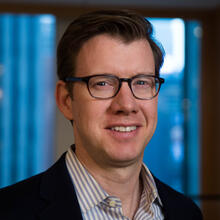Last winter I traveled to Florence, Ariz., to a federal detention facility one hour north of Tucson, where we celebrated a liturgy with 50 men who rarely have a chance to attend Mass and who are separated from their families and friends. We sang hymns together, prayed together and exchanged the sign of peace. I tried to follow along in Spanish.
We were unable to bring cameras or cell phones into the facility, so I will try to give a picture of an event that was very moving for everyone involved.
The Mass was celebrated by Kevin White, S.J., of Jesuit Refugee Service. J.R.S. has a contract with the government to provide chaplains to federal detention centers, and as a new board member I traveled with them to visit some of their ministries near the border. Sister Lynn Allvin, a Dominican, is the chaplain at the Florence facility and helped to organize the liturgy. She celebrates a weekly Communion service for the detainees and assists with counseling.
There are currently 15 immigration detention centers in the United States. Some, like the facility in Florence, are run directly by the government, under the aegis of U.S. Immigration Customs and Enforcement. Others are operated by private contractors. The government is also opening separate facilities for women and children to cope with the influx of families and unaccompanied minors from Central America in 2014. In a recent report, the U.S. bishops called for an end to the detention system in favor of community supervision and support programs for undocumented immigrants.
The facility in Florence is tidy and well maintained, with an outdoor soccer field and common rooms where detainees can gather and watch television. The director of the facility takes pride in its appearance and pointed out, during a tour, how meticulously the trash is disposed of and how the cooling system recirculates air to cut down on odor. But it still looks like a prison, with barbed wire fences, bathrooms with no doors or curtains and dormitories with dozens of bunk beds under harsh fluorescent lights.
We celebrated Mass in the cafeteria. Many of the men who attended were from Central America, others from Mexico, at least one from Haiti. Some of them were picked up trying to cross the border, but others had lived in the United States for years. A simple traffic stop led to their arrest and pending deportation. Some men would be in the detention center for only a few days. The government runs planes to Guatemala from Phoenix every week, and buses travel daily to the border town of Nogales in Mexico. Others would be there longer as they appealed their detention or sought asylum. The average stay is three weeks.
The men looked very young. They were on the short side, and all wore the same government-issued slippers. The facility is only for adult males, but determining the age of a detainee can be difficult. Dentists are brought in to look at their wisdom teeth to try to figure out their age. The men were dressed in blue or orange uniforms, the color designating their security status in the facility. There were no inmates dressed in red, which indicates a high-risk detainee.
We were given stapled-together songbooks and a pamphlet with the readings and responses in English and Spanish. Sister Lynn hung a cross from the wall and designated the songs on a banner using felt numbers. A man played guitar and he and two others led us in song. One of these men, we later learned, has been in the United States for more than 10 years and was now separated from his wife and children.
The readings were recited by the detainees, one in English, one in Spanish. The Gospel for the day told the story of Jesus’ return to Capernaum, where he was soon discovered at home by the crowds. To the paralytic, who was lowered through the roof to be near him, he said, “I say to you, rise, pick up your mat, and go home.” In his homily, Father Kevin White acknowledged that the men before us were on a difficult journey, but he assured the detainees God is with them. I don’t remember if he used the word “accompaniment,” but it was the principal theme of our trip. We could not do anything for these men but be with them.
One man spent most of the Mass on his knees, his hands held up in prayer. Other men looked distraught, but some were smiling—more than I would have expected.
I sat to the left of the detainees, next to the soda machines, with staff and board members from J.R.S. We were greeted with applause upon our arrival, and a few men made their way over to us during the sign of peace to give us their hands. I wondered what they knew about us and why we were there.
The Mass lasted about an hour. The microphone didn’t always work, and at the end Sister Lynn asked who in the congregation was celebrating a birthday this month. A few men raised their hands. There were at least two guards in the room. Occasionally we could hear their radios go off.
At the end of Mass, some of the men came up to us again, said hello and shook our hands. We did not learn their names. Many of them are known to staff only by their “alien number.” Sister Lynn tries to learn their names and on occasion will call them Mr. García or Mr. Pérez.
The men often leave the facility abruptly. One day they are there, the next they are gone. The chaplains often don’t get to say goodbye, but sometimes they do. Sister Lynn tells them that they will see each other again in heaven.








